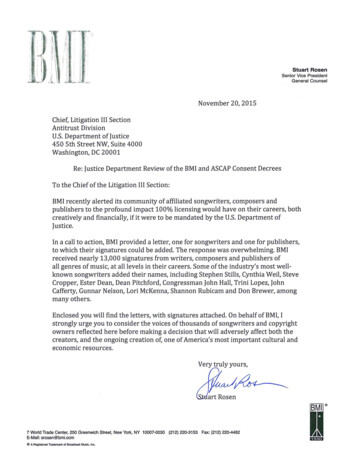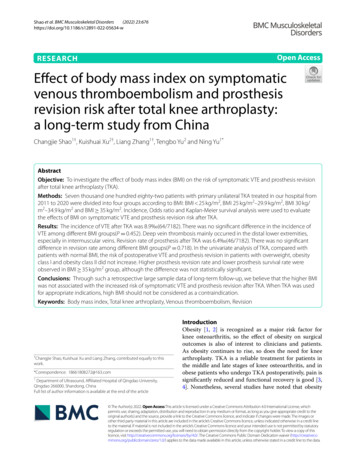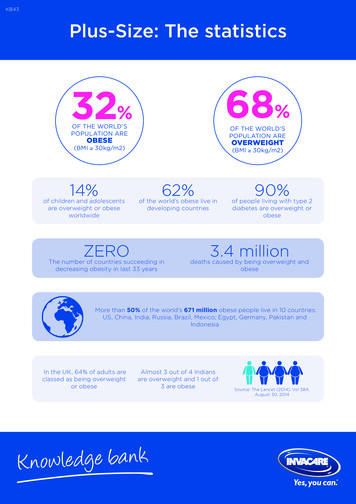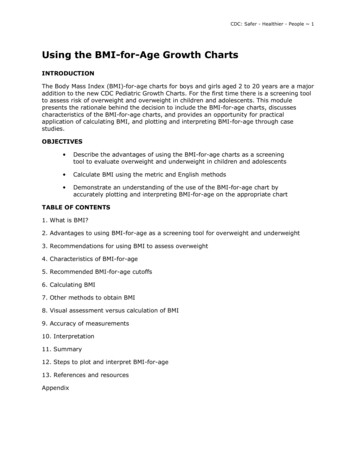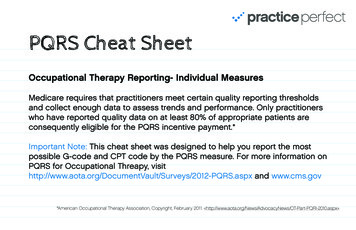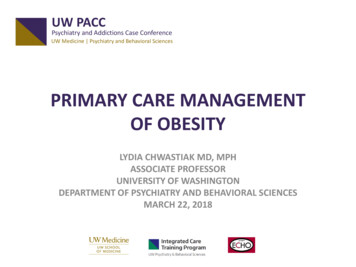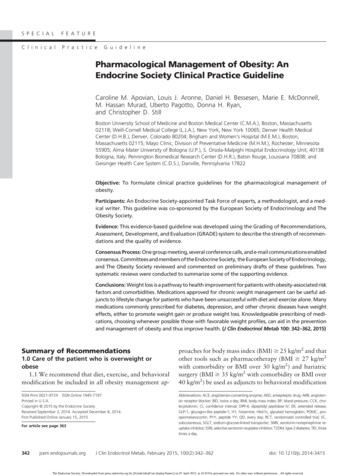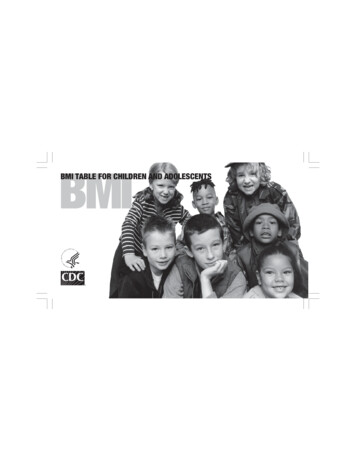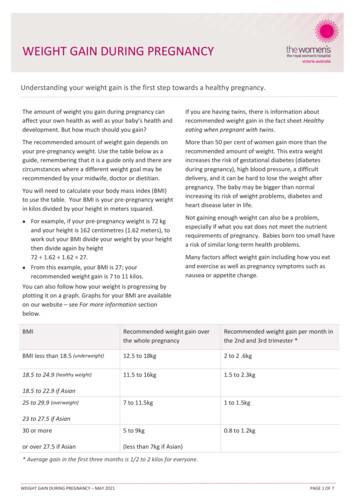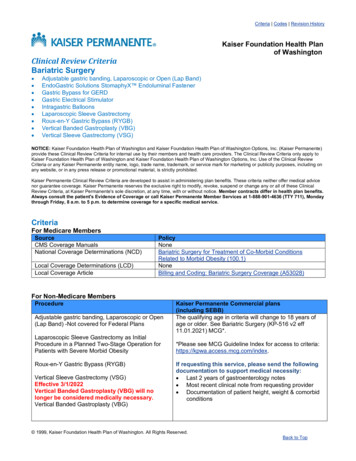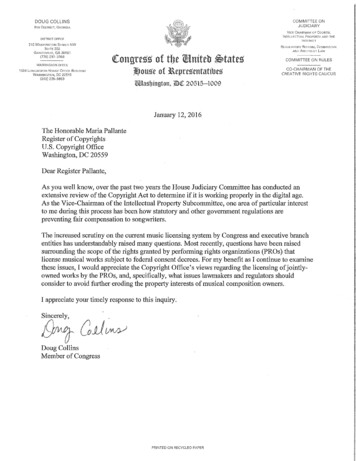
Transcription
The Register of Copyrights of the United States of AmericaUnited States Copyright Office · 101 Independence Avenue SE ·Washington, DC 20559-6000 · (202) 707-8350January 29, 2016Dear Vice-Chairman Collins:On behalf of the United States Copyright Office, I am pleased to deliver the attached response toyour letter of January 12, 2016 requesting the views of the Copyright Office regarding thelicensing of jointly owned works by the performing rights organizations ("PROs").We appreciate your continuing interest in the fair and efficient functioning of our music licensingsystem, which, as you know, was the subject of the Office's February 2015 report, Copyrightand the Music Marketplace. Please do not hesitate to contact me should you require any furtherinformation on this subject.Respectfully,Maria A. PallanteEnclosureThe Honorable Doug CollinsVice-ChairmanSubcommittee on Courts, Intellectual Property and the InternetUnited States House of Representatives1504 Longworth House Office BuildingWashington, D.C. 20515
Views of the United States Copyright Office ConcerningPRO Licensing of Jointly Owned WorksIn February 2015, the Copyright Office released a comprehensive report on U.S. musiclicensing practices, Copyright and the Music Marketplace. 1 The report surveys the currentmusic licensing landscape—much of which is subject to government regulation, including thefederal antitrust consent decrees that govern the performing rights organizations (“PROs”)ASCAP and BMI 2—and recommends a number of structural changes. The Office hopes thatCongress will consider the Office’s suggestions for reform of the music licensing system as itcontinues its review of the nation’s copyright laws. 3The Office’s report followed an extensive public process conducted in 2014 that includedwritten submissions from interested parties—including songwriters, recording artists, musicpublishers, record companies, licensing entities, public interest organizations, and digital musicservices—and six days of hearings held in Nashville, Los Angeles, and New York. 4 Throughoutthe study, participants expressed concerns regarding fair compensation for music creators, theinefficiency of current licensing practices, the lack of authoritative data to facilitate theidentification of music, and the need for greater transparency in usage and payment information.The Office’s recommendations aim to address these concerns by ensuring a fair and efficientlicensing regime.In recent months, the Office has become aware that a new and significant issue has arisenunder the PRO consent decrees regarding the scope of rights granted to licensees by ASCAP andBMI. More specifically, we understand that as part of an ongoing review of the decrees by theDepartment of Justice (“DOJ”), DOJ is considering whether the decrees may properly beinterpreted to require ASCAP and BMI to license 100 percent of the rights required to publiclyperform any musical work in their respective repertoires, regardless of whether the work iswholly or only partially owned by the member (or members) of the PRO in question. 5 We refer1See generally U.S. COPYRIGHT OFFICE, COPYRIGHT AND THE MUSIC MARKETPLACE (2015), pyright-and-the-music-marketplace.pdf (“COPYRIGHT AND THE MUSICMARKETPLACE”).2United States v. ASCAP, No. 41–cv–1395, 2001–2 Trade Cas. (CCH) ¶ 73,474, 2001 WL 1589999 (S.D.N.Y. June11, 2001) (“ASCAP Consent Decree”); United States v. BMI, No. 64–cv–3787, 1966 Trade Cas. (CCH) ¶ 71,941(S.D.N.Y. 1966), as amended, 1996-1 Trade Cas. (CCH) ¶ 71,378, (S.D.N.Y. Nov. 18, 1994) (“BMI ConsentDecree”), available at 66/download.3See 17 U.S.C. § 701(b)(1), (4) (providing that the Register of Copyrights shall advise Congress on issues relatingto and conduct studies regarding copyright, other matters arising under Title 17 and related matters).4COPYRIGHT AND THE MUSIC MARKETPLACE at 14-15.5DOJ initiated a review of the consent decrees in June 2014. See Ed Christman, U.S. Dept. of Justice to ReviewASCAP and BMI Consent Decrees, BILLBOARD (June 4, 2014), http://www.billboard.com/biz/articles/news/legal-1
to the approach of granting full rights to use a co-owned work based upon a partial interest in thework herein as “100-percent licensing.” A 100-percent licensing approach stands in contrast tothe practice of licensing only partial interests in co-owned works, commonly referred to as“fractional licensing.”Significantly, in the Office’s recent study, the fractional licensing of jointly ownedmusical works—a longstanding practice of the music industry—went unquestioned as abackground fact by the many stakeholders who participated, including both licensors andlicensees. 6 As noted by the Office in the resulting report, “[n]otwithstanding the default rules ofjoint copyright ownership, publishers and songwriters frequently have understandings that theyare not free to license each other’s respective shares.” 7 Despite the wide-ranging nature of thestudy and invitation to raise additional issues, 8 none of the participants identified fractionallicensing of musical works by the PROs as a practice that needed to be changed.On January 12, 2016, the Register of Copyrights received an inquiry from RepresentativeDoug Collins, Vice-Chairman of the Subcommittee on Courts, Intellectual Property and theInternet of the House Committee on the Judiciary, requesting the views of the Copyright Office“regarding the licensing of jointly-owned works by the PROs, and, specifically, what issueslawmakers and regulators should consider to avoid further eroding the property interests ofmusical composition owners.” 9 In responding, the Office addresses here the issues ce-to-review-ascap-and-bmi-consent; Antitrust Division Review ofASCAP and BMI Consent Decrees 2014, DOJ, http://www.justice.gov/atr/ascap-bmi-decree-review (last updatedDec. 16, 2015). On September 22, 2015, the DOJ’s Antitrust Division requested comments on PRO licensing ofjointly owned works. Antitrust Division Requests Comments on PRO Licensing of Jointly Owned Works, ecree-review-ascap-and-bmi-2015 (last updated Dec. 16, 2015) (“DOJRequest for Comments on Jointly Owned Works”). In its request, DOJ states that “ASCAP’s and BMI’s licensingpractices suggest that each organization has historically provided licenses entitling users to play all works in theirrepertories, whether partially or fully owned,” but also notes that “the historical practice by which ASCAP and BMIhave made and accepted payments has been based on the fractional interest each copyright owner holds in works.”Id. The request asks whether, notwithstanding that historical practice, the consent decrees are properly interpreted“to currently require ASCAP and BMI to offer full-work [i.e. 100-percent] licenses” to play all of the works in eachorganization’s respective repertoire. Id. References to comments responding to the DOJ’s request, available on theDOJ website at , are by party name (abbreviated whereappropriate) followed by “Jointly Owned Works Comments” (e.g., “ASCAP Jointly Owned Works Comments”).6See, e.g., Spotify USA Inc., Comments Submitted in Response to U.S. Copyright Office’s March 17, 2014 Noticeof Inquiry at 4 (May 23, 2014) (“Although the Copyright Laws provide that a nonexclusive licensee of a co-authorof a joint work may not be sued for copyright infringement, custom and practice in the music industry has developedsuch that each co-author of a musical work only licenses its proportionate share in the underlying work.”); Tr. at145:03-150:07 (June 24, 2014) (Chertkof, RIAA; Gibbs, Content Creators Coalition; Barker, Interested PartiesAdvancing Copyright) (discussing, inter alia, practice of fractional licensing between songwriter collaborators); seealso Susan Butler, Risky Business: Songs in Fractions (Part One of Two), MUSIC CONFIDENTIAL (Sept. 4, 2015)(noting that “rights holders have been licensing only their rights/shares in songs in countless business deals fordecades”).7COPYRIGHT AND THE MUSIC MARKETPLACE at 163.8See Music Licensing Study: Notice and Request for Public Comment, 78 Fed. Reg. 14,739, 14,742-43 (Mar. 17,2014); Music Licensing Study: Second Request for Comments, 79 Fed. Reg. 42,833, 42,834-35 (July 23, 2014).9Letter from Rep. Doug Collins, Vice-Chairman, Subcomm. on Courts, Intellectual Prop., & the Internet of the H.Comm. on the Judiciary, to Maria A. Pallante, Register of Copyrights and Dir., U.S. Copyright Office, at 1 (Jan. 12,2016).2
100-percent versus fractional administration of jointly owned musical works, in particular asthese issues relate to the functioning of ASCAP and BMI. The Office believes that aninterpretation of the consent decrees that would require these PROs to engage in 100-percentlicensing presents a host of legal and policy concerns. Such an approach would seemingly vitiateimportant principles of copyright law, interfere with creative collaborations among songwriters,negate private contracts, and impermissibly expand the reach of the consent decrees. It couldalso severely undermine the efficacy of ASCAP and BMI, which today are able to grant blanketlicenses covering the vast majority of performances of musical works—a practice that isconsidered highly efficient by copyright owners and users alike. 10Because the industry practice of fractional licensing of performance rights—as well asmechanical and synchronization rights, the other primary sources of licensing income forsongwriters and music publishers 11—has been amply documented in the submissions ofcommenting parties in the DOJ’s pending review process, 12 the below analysis assumes thatfact 13 and focuses primarily on the legal consequences that follow. In addition to relevant10COPYRIGHT AND THE MUSIC MARKETPLACE at 170 (“Throughout [the study], the Office . . . heard consistentpraise for the efficiencies of blanket licensing by . . . the PROs . . . .”).11See AL K OHN & B OB KOHN, KOHN ON MUSIC LICENSING 329 (4th ed. 2010) (“Kohn”) (stating that “[a]nyonewho regularly seeks to clear licenses for the use of music in motion pictures, television programs, or advertisementsshould be quite familiar with . . . . one of the most frustrating barriers to clearing licenses: locating and obtainingpermission from each of the several owners of the copyright”); Frequently Asked Questions: Mechanical,Synchronization & Other Licensing, SESAC, http://www.sesac.com/Licensing/FAQsOther.aspx (last visited Dec. 31,2015) (stating that licensees need to contact all of the publishers or their administrators of a song in order to obtain asynchronization or mechanical license); see also National Music Publishers’ Association (“NMPA”) Jointly OwnedWorks Comments at 7 (stating that the “system of fractional licensing is consistent with how all music markets work,from synchronization rights to lyric rights to performance rights”); Donald S. Passman of Gang, Tyre, Ramer &Brown, Inc. on behalf of NMPA (“Passman/NMPA”) Jointly Owned Works Comments at 3-4 (“[T]he reality is thatlicensees in every other endeavor (e.g., synchronization rights . . ., mechanical licenses . . ., and print licenses) livein a world of fractional licensing and have no problem securing licenses.”).12See, e.g., ASCAP Jointly Owned Works Comments at 1 (“‘[F]ractional licensing’ is fully consistent withASCAP’s historical licensing practices . . . . ASCAP and music users have historically negotiated and priced blanketlicenses based on the fractional interest of the works in ASCAP’s repertory.”); BMI Jointly Owned WorksComments at 3-5 (“It is indisputable . . . that the market has consistently embraced a fractional-licensing model.”);NMPA Jointly Owned Works Comments at 6 (“ASCAP and BMI have historically licensed only the fractionalshares of copyrights owned or controlled by their respective songwriter and music publisher members . . . andaffiliates . . . .”); National Academy of Recording Arts & Sciences Jointly Owned Works Comments at 6 (“Althoughthe consent decrees as originally written may be ambiguous, the current business practice is not. Fractionallicensing is a practice accepted by both the PROs and their licensees and it is relied upon by the songwriters whodepend on the PROs to represent their interests.”); SESAC Jointly Owned Works Comments at 1 (arguing that 100percent licensing would “[d]isrupt decades of industry practice, under which PROs license works only for thepercentage of rights held by their members in those works”).13While fractional licensing is the industry norm, a few exceptions to the general rule have come to the Office’sattention in preparing these comments. First, as noted below, as a result of a 1994 decision by the ASCAP rate court,United States v. ASCAP (In Re Application of Buffalo Broad. Co.), No. 13-95 (WCC), 1993 WL 60687 (S.D.N.Y.Mar. 1, 1993), aff’d in part vacated in part, 157 F.R.D. 173 (S.D.N.Y. 1994), ASCAP and BMI issue a small portionof “per-program” licenses on a 100-percent basis. BMI Jointly Owned Works Comments at 15 n.18. In addition,the Office understands that some digital services (perhaps aware of the issue raised under the consent decrees) havebeen seeking 100-percent licenses from publishers—a development that has generated concerns. See Matt Pincus,SONGS Music CEO Matt Pincus: Why Music Publishing's Two-Class System Could Spell the End for New Indie3
statutory and decisional law, as explained below, the Office has reviewed representativecontractual provisions between and among songwriters and music publishers in preparing theseviews. 14I.BackgroundA.Relevant Principles of Copyright LawThe exclusive rights of authors and owners in musical works are shaped by severalimportant principles of copyright law.1.Divisibility and Transferability of Copyright InterestsThe 1976 Copyright Act (the “1976 Act” or “Act”) grants authors of copyrighted works abundle of exclusive rights, namely the rights to do and to authorize the reproduction, preparationof derivative works, distribution, public performance, and public display of those works. 15Although copyright vests initially in the author or authors of a work, 16 the Act provides that itcan be transferred to another person “in whole or in part.” 17 The Act further specifies that thebundle of exclusive rights, including “any subdivision of any of the rights specified,” may bedivided and owned separately. 18It is well established that the Act gives copyright owners the right to transfer anownership interest in all or part of one or more of their exclusive rights. 19 This principle ofFirms, BILLBOARD (Oct. 29, 2015), ishings-two-class-system (noting Apple’s call for 100-percent licensing and predictingthat this will lead to “[m]ore control to the bigger companies”). Finally, the Office notes that regulations governingthe statutory license under 17 U.S.C. § 115 for making and distributing phonorecords of nondramatic musical worksthat date back to the 1970s allow service of compulsory license notices on and payment of royalties to a single coowner. See 37 C.F.R. §§ 201.18(a)(6), 210.16(g)(1), 201.17(g)(1); see also Compulsory License for Making andDistributing Phonorecords, 42 Fed. Reg. 64,889, 64,891-92 (Dec. 29, 1977) (interim rule); Compulsory License forMaking and Distributing Phonorecords, 45 Fed. Reg. 79,038, 79,045-46 (Nov. 28, 1980) (final rule). For decades,the section 115 compulsory license was rarely used, as licensees instead obtained voluntary licenses on a fractionalbasis through The Harry Fox Agency or from the publisher directly, and such voluntary licensing continues to be thedominant practice today. COPYRIGHT AND THE MUSIC MARKETPLACE at 30-31. In recent years, however, digitalproviders have invoked the compulsory process under section 115 to address licensing gaps. See id. As a result, theOffice is now hearing of legal and administrative concerns arising from this aspect of the Office’s regulations.14Of course, the Office’s review of industry contractual provisions could not be comprehensive. It is worth noting,however, that our examination of representative clauses in songwriter and publisher agreements from varioussources revealed numerous references to fractional ownership and licensing and no provisions that appearedinconsistent with these practices.1517 U.S.C. § 106.16Id. § 201(a).17Id. § 201(d)(1).18Id. § 201(d)(2) (“Any of the exclusive rights comprised in a copyright, including any subdivision of any of therights specified by section 106, may be transferred . . . and owned separately.”).19See Minden Pictures, Inc. v. John Wiley & Sons, Inc., 795 F.3d 997, 1002-03 (9th Cir. 2015) (“[T]he CopyrightAct permits the copyright owner to subdivide his or her interest in what otherwise would be a wholly owned‘exclusive right’ by authorizing the owner to transfer his or her share, ‘in whole or in part,’ to someone else.”);4
divisibility in the current Act represents a departure from the 1909 Copyright Act, whichprovided that ownership of a copyright could only be transferred in whole. 20 In instituting thisstatutory reform, Congress intended that “[e]ach of the five enumerated rights may be subdividedindefinitely and . . . each subdivision of an exclusive right may be owned and enforcedseparately.” 21 Accordingly, under the 1976 Act, “a copyright owner can freely transfer anyportion of his ownership interests in that copyright . . . [as] the plain language of § 201(d)commands as much.” 22The 1976 Act further provides that “[t]he owner of any particular exclusive right isentitled, to the extent of that right, to all of the protection and remedies accorded to the copyrightowner by this title.” 23 For example, “[i]t is established law under the 1976 Act that any party towhom such a right has been transferred—whether via an assignment or an exclusive license—has standing to bring an infringement action based on that right,” even when that party has beentransferred only “a share of such a right.” 24A copyright owner may transfer a partial or entire ownership interest in one or moreexclusive rights through a signed writing. 25 It should also be noted that fractional interests incopyrights can arise by other means, such as by bequest, state laws of intestacy, or lawsgoverning the division of marital property. 26A copyright owner may also grant a nonexclusive license to use a work. A nonexclusivelicensee, however, is not considered to have an ownership interest in the work and does not haveGardner v. Nike, Inc., 279 F.3d 774, 779 (9th Cir. 2002) (“Section 201(d)(1) enables the owner to transfer anyfraction of his or her ownership interest to another party, thereby making that party a whole or joint owner.”).203 MELVILLE NIMMER & DAVID NIMMER, NIMMER ON COPYRIGHT § 10.01[A] (Matthew Bender rev. ed. 2015)(“Because the 1909 Act spoke of a single ‘copyright’ to which the author of a work was entitled, and referred in thesingular to ‘the copyright proprietor,’ it was inferred that the bundle of rights which accrued to a copyright ownerwere ‘indivisible,’ that is, incapable of assignment in parts.” (citations omitted)); New York Times Co., Inc. v. Tasini,533 U.S. 483, 495-96 (2001) (explaining that the “1976 Act rejected the doctrine of indivisibility, recasting thecopyright as a bundle of discrete ‘exclusive rights[]’ . . . each of which ‘may be transferred . . . and ownedseparately’”).21H.R. REP. NO. 94-1476, at 61 (1976), reprinted in 1976 U.S.C.C.A.N. 5659, 5674 (“1976 House Report”).22Corbello v. DeVito, 777 F.3d 1058, 1065 (9th Cir. 2015).2317 U.S.C. § 201(d)(2).24Minden, 795 F.3d at 1002-03; see also 17 U.S.C. § 501(b) (“The legal or beneficial owner of an exclusive rightunder a copyright is entitled . . . to institute an action for any infringement of that particular right committed whilehe or she is the owner of it.”).2517 U.S.C. § 204(a) (“A transfer of copyright ownership, other than by operation of law, is not valid unless aninstrument of conveyance, or a note or memorandum of the transfer, is in writing and signed by the owner of therights conveyed or such owner’s duly authorized agent.”).26See id. § 201(d)(1) (“The ownership of a copyright may be transferred in whole or in part . . . by operation of law,and may be bequeathed by will or pass as personal property by the applicable laws of intestate succession.”); see 1PAUL GOLDSTEIN, GOLDSTEIN ON COPYRIGHT § 5.1.6.2 (supp. 2011) (“1 GOLDSTEIN ON COPYRIGHT”) (“Copyrights,like other personal property, may constitute community property in states that have adopted a community propertyregime . . . . Outside the community property regime, copyrights may be subject to division between husband andwife in the increasing number of states that have adopted a rule of equitable allocation upon dissolution of amarriage.”).5
the ability to pursue an infringement action. 27 Unlike an ownership interest, a nonexclusivelicense need not be conveyed in writing. 282.Joint WorksUnder the Act, when a work is “prepared by two or more authors with the intention thattheir contributions be merged into inseparable or interdependent parts of a unitary whole,” theresulting work is considered a “joint work.” 29 Joint authors, in the absence of agreement to thecontrary, share equal and undivided ownership of the joint work. 30 For example, where threesongwriters intend to, and do, collaborate on a single musical work, copyright law vests eachsongwriter with an undivided one-third interest in the copyright for the entire work.Co-owners of a joint work “[are] treated generally as tenants in common, with eachcoowner having an independent right to use [or] license the use of a work, subject to a duty ofaccounting to the other coowners for any profits.” 31 Each co-owner may thus grant anonexclusive license to use the entire work without the consent of other co-owners, provided thatthe licensor accounts for and pays over to his or her co-owners their pro-rata shares of theproceeds. 32 A co-owner of a joint work may also unilaterally assign or exclusively license his orher own interest in the copyright, in whole or in part, to a third party, because to do so will notimpair the rights of the other co-owners. 33 But a co-owner may not transfer the entire copyright,or grant an exclusive license to the entire work, as that would affect the rights of the other coowners; thus, a transfer of ownership or grant of an exclusive license can occur only through thesigned, written agreement of all co-owners. 34While the 1976 Act establishes default rules for joint works, it must be remembered thatthey are subject to the Act’s express provision that a copyright, and the exclusive rightsthereunder, can be divided and separately owned. 35 As a leading treatise explains, the defaultrules within the Act are only a “starting point,” with “collaborators . . . free to alter this statutoryallocation of rights and liabilities by contract.” 36 Examples of such agreements by copyright27Minden, 795 F.3d at 1002-03.Effects Assocs., Inc. v. Cohen, 908 F.2d 555, 558 (9th Cir. 1990).2917 U.S.C. § 101.30Id. § 201(a); see also Richlin v. Metro-Goldwyn-Mayer Pictures, Inc., 531 F.3d 962, 968 (9th Cir. 2008); 1MELVILLE NIMMER & DAVID NIMMER, NIMMER ON COPYRIGHT § 6.08 (Matthew Bender rev. ed. 2015) (“1 NIMMERON COPYRIGHT”).311976 House Report at 121.32Community for Creative Non-Violence v. Reid, 846 F.2d 1485, 1498 (D.C. Cir. 1988) (“Joint authors co-owningcopyright in a work . . . ‘each hav[e] an independent right to use or license the copyright, subject only to a duty toaccount to the other co-owner for any profits earned thereby.’” (quoting WILLIAM PATRY, LATMAN’S THECOPYRIGHT LAW 116 (6th ed. 1986))), aff'd without consideration of this point, 490 U.S. 730 (1989); Davis v. Blige,505 F.3d 90, 100 (2d Cir. 2007); U.S. COPYRIGHT OFFICE, JOINT OWNERSHIP OF COPYRIGHTS 93-96 (Comm. Print1958) (prepared by George D. Cary), available at http://copyright.gov/history/studies/study12.pdf; see also 1NIMMER ON COPYRIGHT § 6.11.33Davis v. Blige, 505 F.3d at 99; 1 NIMMER ON COPYRIGHT § 6.11.3417 U.S.C. § 204(a); 1 NIMMER ON COPYRIGHT § 6.11.3517 U.S.C. § 201(d).361 GOLDSTEIN ON COPYRIGHT § 4.2.286
owners—particularly in collaborative industries such as music and book publishing—includearrangements to alter the presumptively equal undivided interests in the copyright to awork, 37 prohibit co-owners from independently licensing a work, 38 and waive accountings fromco-owners. 39Finally, it is important to recognize that the United States’ rules on joint authorship differfrom those of many other countries that require the consent of all co-owners for any license, notonly an exclusive license. 40 In addition to rights in foreign works, foreign law may also governthe joint work of a U.S. and foreign songwriter. 413.Derivative Works and CompilationsUnder the Copyright Act, a work in which an author incorporates material from one ormore already existing works may be a derivative work or a compilation. Works that incorporatepreexisting material are eligible for copyright protection to the extent that the underlyingmaterial is used in a lawful manner. 42A derivative work is a creation based upon one or more preexisting works, in which theunderlying work has been “recast, transformed, or adapted.” 43 In such a case, the author of theoriginal work (or the author’s successor) continues to own the copyright in the preexisting work,while the creator of the derivative owns only the new contributions. The creator of the derivativetherefore may not license the derivative work without the consent of the owner of the underlying37Id. § 4.2 n.5 (noting that “coauthors can contractually alter their equal undivided interests in the copyright to thework”).38See, e.g., Corbello v. DeVito, 832 F. Supp. 2d 1231, 1244 (D. Nev. 2011) (explaining that “[j]oint owners mayagree by contract that none of them shall independently license a work”); see also 1 GOLDSTEIN ON COPYRIGHT §4.2 n.5 (stating that “the coauthors can contractually limit the freedom that each would otherwise enjoy to exploitthe work without permission from the others”).39Wilcox v. Career Step, LLC, 929 F. Supp. 2d 1155, 1168 (D. Utah 2013) (holding that a co-owner of joint workcan, through an express agreement, waive right to accounting from a co-owner).40See, e.g., 1 NIMMER ON COPYRIGHT § 6.10[D] (citing legal precedent from the United Kingdom, France, Italy,Japan, Mexico, and Canada to document that in many “foreign jurisdictions, a license will not be valid unless alljoint owners are party to it . . . . [and thus], the licensee of a single joint owner will be unable to exploit his work[outside the United States]”).41There is no bright line rule for determining when to apply U.S. or foreign law to such a work. See 2 JANEGINSBURG, INTERNATIONAL COPYRIGHT AND NEIGHBOURING RIGHTS § 20.40, at 1318-20 (2005) (“Ginsburg”)(describing potential choice of law principles for determining joint ownership rights including “the law of thecountry in which a majority of the creators reside,” or “the law of the country the creators designate by contract”); cf.Itar-Tass Russian News Agency v. Russian Kurier, Inc., 153 F.3d 82, 90 (2d Cir. 1998) (suggesting that the law ofthe country with the “‘most significant relationship’ to the property and the parties” would govern ownership rightsin the case of a conflict of laws (quoting RESTATEMENT (SECOND) OF CONFLICT OF LAWS § 222 (1971))).4217 U.S.C. § 103(a) (“[P]rotection for a work employing preexisting material in which copyright subsists does notextend to any part of the work in which such material has been used unlawfully.”).43Id. § 101 (“A ‘derivative work’ is a work based upon one or more preexisting works . . . [in] any . . . form inwhich a work may be recast, transformed, or adapted.”).7
work unless there is an alternative legal basis to do so, such as that the original has fallen into thepublic domain. 44A compilation is created when preexisting materials, which may constitute separate andindependent works in themselves, are assembled into a new work of authorship. 45 As in the caseof a derivative work, the copyright in a compilation extends only to the material contributed bythe author of the new work, and does not include the underlying material. 46 Accordingly, thecreator of a compilation needs permission to license use of the work’s constituent elements(again, absent other legal authority). 47In sum, absent a collaboration in the new work, the author of a derivative work orcompilation does not share a joint copyright with the author of the underlying work(s), or viceversa.B.Ownership and Administration of Multi-Author Musical WorksSongs are frequently created by more than one author. 48 The archetypal image of twosongwriters sitting together in a room with a piano and collaborating on music and lyricsexemplifies the concept of a copyrightable joint work.That said, however, it is important to realize that many songs with more than one authorare not actually written this way. A song may incorporate samples of, or remix, preexistingworks. In such a case, the song could be a derivative work or compilation, rather than a jointwork, for purposes of copyright law. Moreover, much contemporary music, particularly of thepop and urban genres, is created by assembling contributions from various sources—the “beats,”“hook,” instrumental track and melody or “topline” may be sourced from different creators44Id. § 103(b) (“The copyright in a compilation or derivative work extends only to the material contributed by theauthor of such work, as distinguished from the preexisting material employed in the work, and does not imply anyexclusive right in the
the study, participants expressed concerns regarding fair compensation for music creators, the inefficiency of current licensing practices, the lack of authoritative data to facilitate the identification of music, and the need for greater transparency in usage and payment information.
